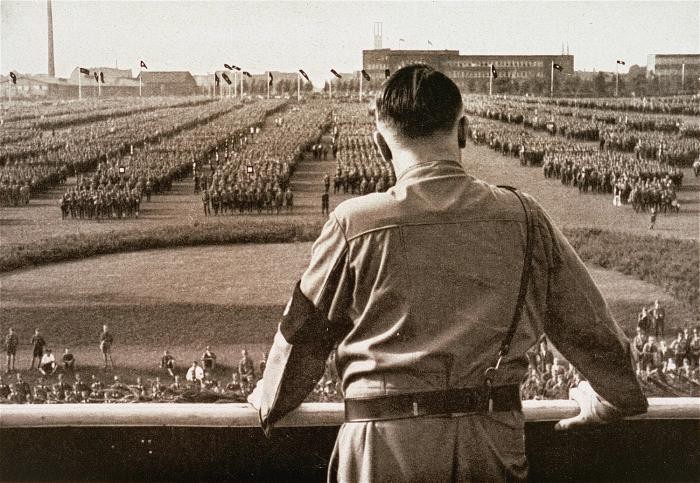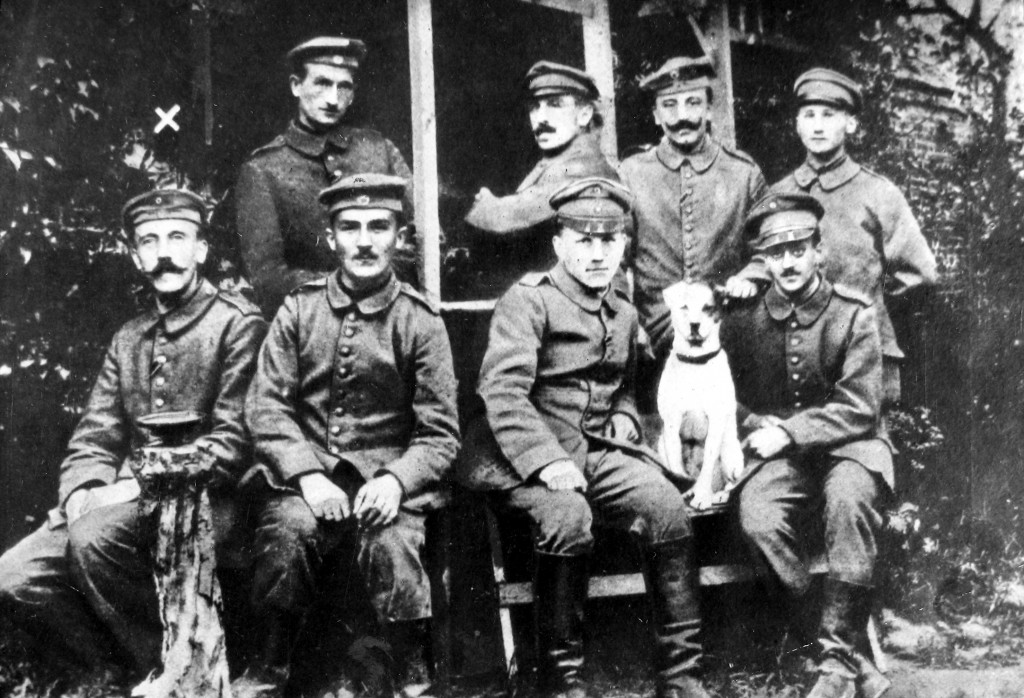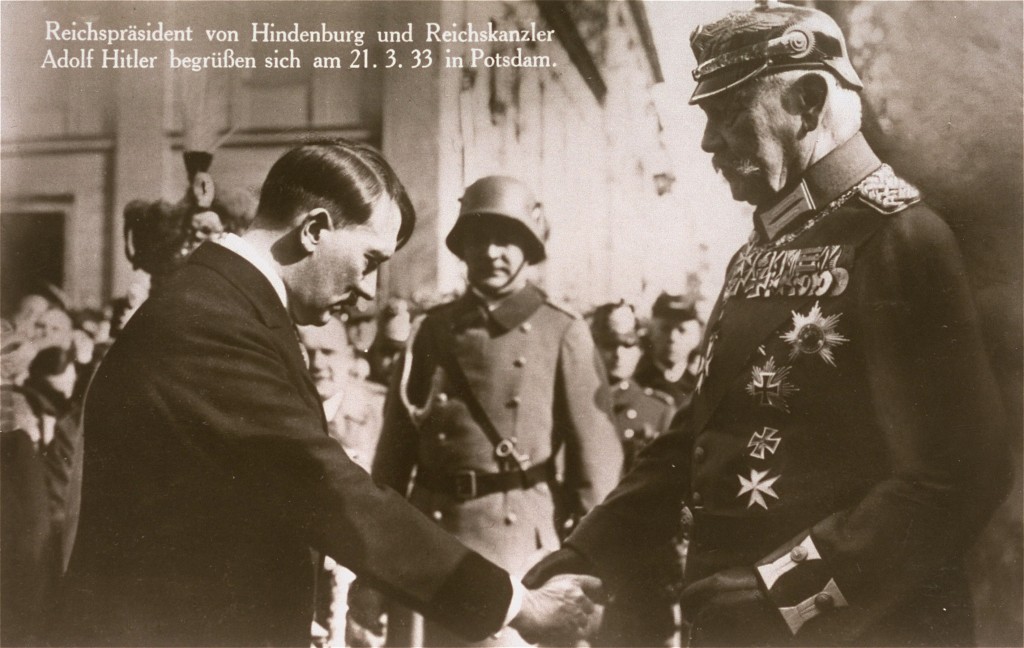
Adolf Hitler
Adolf Hitler was the undisputed leader of the National Socialist German Workers Party—known as Nazis—since 1921. In 1923, he was arrested and imprisoned for trying to overthrow the German government. His trial brought him fame and followers. He used the subsequent jail time to dictate his political ideas in a book, Mein Kampf—My Struggle. Hitler’s ideological goals included territorial expansion, consolidation of a racially pure state, and elimination of the European Jews and other perceived enemies of Germany.
Key Facts
-
1
After his release from prison in 1924, Hitler began seeking political power through legal means, such as elections, rather than through violent attempts to overthrow the government.
-
2
Modern propaganda techniques—including strong images and simple messages—helped propel Austrian-born Hitler from a little known extremist to a leading candidate in Germany’s 1932 presidential elections.
-
3
A common misconception about Hitler’s rise to power is that he was voted into office. In January 1933, President Paul von Hindenburg appointed Hitler Chancellor, the head of the German government.
Early Years and World War I
Adolf Hitler (1889–1945) was born on April 20, 1889, in the Upper Austrian border town Braunau am Inn. In 1898, the Hitler family moved to Linz, the capital of Upper Austria. Seeking a career in the visual arts, Hitler fought bitterly with his father, who wanted him to enter the Habsburg civil service.

Hitler lived in Vienna between February 1908 and May 1913, when he left for Munich. There, he drifted and supported himself by painting watercolors and sketches until World War I gave new direction to his life. He joined the army. During the war, he was wounded twice (in 1916 and 1918) and was awarded several medals.
In October 1918, after he was partially blinded in a mustard gas attack near Ypres in Belgium, Hitler was sent to a military hospital in Pasewalk. News of the November 11, 1918, armistice reached him there as he was recuperating. Released from the hospital in November 1918, Hitler returned to Munich.
In 1919, he joined the Information Office of the Bavarian Military Administration. This office gathered intelligence on civilian political parties and provided anti-Communist “political education” for the troops. In August 1919, as a course instructor, Hitler made his first virulent antisemitic speeches. A month later, he first expressed an antisemitic, racist ideology on paper, advocating removal of Jews from Germany.
Leader of the Nazi Party
Hitler joined what would become the Nazi Party in October 1919. He helped devise the party political program in 1920. The program was based on racist antisemitism, expansionist nationalism, and anti-immigrant hostility. By 1921, he was the absolute Führer (Leader) of the Nazi Party. Membership in the Nazi Party swelled in two years to 55,000, supported by more than 4,000 men in the paramilitary SA (Sturmabteilung; Storm Troopers).
Imprisonment
Rejecting political participation in Weimar elections, Hitler and the Nazi Party leadership sought to overthrow the government of Bavaria, a state in the Weimar Republic. The Beer Hall Putsch took place on November 9, 1923. After the putsch collapsed, a Munich court tried Hitler and other ringleaders on charges of high treason. Hitler used the trial as a stage to attack the system of parliamentary democracy and promote xenophobic nationalism. Hitler was found guilty, but received a light sentence and was released after serving just one year in detention. He used his time in prison to begin writing Mein Kampf (My Struggle), his autobiography, published in 1926. In the book, he unveiled an explicitly, race-based Nationalist, social Darwinist, and antisemitic vision of human history. He advocated dictatorship at home, military expansion, and seizure of “living space” (Lebensraum) in the East. This living space was where the Germans intended to cleanse the east of indigenous and “inferior” populations.
Political Strategy
After his release from prison, Hitler reorganized and reunified the Nazi Party. He changed its political strategy to incorporate engagement in electoral politics, programs targeting new and alienated voters, and bridge building to overcome traditional conflicts in German society.
Using language fashioned to reflect the fears and hopes of potential voters, the Nazis campaigned for
- Renewing national defense capacity
- Restoring national sovereignty
- Annihilating Communism
- Overturning the Versailles Treaty
- Eliminating foreign and Jewish political and cultural influence in Germany and reversing the moral depravity that it allegedly created
- Generating economic prosperity and creating jobs
Testing this strategy in the national parliamentary elections of 1928, the Nazis received a disappointing 2.6% percent of the vote.
With the onset of the Great Depression in 1930, Nazi agitation began to have increasing impact in the German population. When the majority coalition government collapsed in March, the three middle-class parties invoked emergency constitutional provisions to hold extraordinary parliamentary elections, hoping to manufacture a governing majority that would permanently exclude the Social Democrats and the political Left from governing. When this maneuver failed, German governments in 1930-1932 resorted to ruling by presidential decree rather than parliamentary consent.
Electoral Breakthroughs
The Nazis made their electoral breakthrough in 1930 by combining modern technology, modern political market research, and intimidation through violence for which the leadership could deny responsibility. The party’s youthful energy untainted by past association with democratic governments also helped them break through electoral barriers. They captured nearly a fifth of the popular vote, attracting new, unemployed, and alienated voters.
Hitler was a powerful and spellbinding speaker who attracted a wide following of Germans desperate for change. The Nazi appeal grew steadily in 1931 and 1932, creating a sense of inevitability that Hitler would come to power and save the country from political paralysis, economic impoverishment, cultural atrophy, and Communism. After running for President of the Republic in spring 1932, Hitler and the Nazis captured 37.3% of the vote in the July 1932 elections. They became the largest political party in Germany. Constant electioneering after 1930, accompanied by politically-motivated street violence, swelled the membership of the Nazi Party to 450,000, the SA to more than 400,000, and the SS to more than 50,000 in 1932.
Chancellor of Germany

The Nazi share of the vote declined to 33.1 % in the November 1932 parliamentary elections. The decrease blunted Hitler’s appeal and created a political and financial crisis in the Nazi Party. Former Chancellor (June-November 1932) Franz von Papen rescued Hitler. Von Papen believed that Nazi electoral losses rendered them more susceptible to control by the more experienced but unpopular conservative elites. Willing to risk a Nazi-German nationalist coalition with Hitler as Chancellor, von Papen reached agreement with Hitler and the German Nationalists in early January 1933. He persuaded President Paul von Hindenburg that Germany was out of other options. Reluctantly, von Hindenburg appointed Hitler Chancellor on January 30, 1933.
Following his appointment as chancellor, Adolf Hitler began laying the foundations of the Nazi state. He seized every opportunity to turn Germany into a one-party dictatorship.
German president Paul von Hindenburg died in August 1934. Hitler had secured the support of the army with the Röhm purge of June 30, 1934. He abolished the presidency and proclaimed himself Führer of the German people (Volk). All military personnel and all civil servants swore a new oath of personal loyalty to Hitler as Führer. Hitler also continued to hold the position of Reich Chancellor (head of government).
Critical Thinking Questions
The Nazi regime required the active help or cooperation of professionals working in diverse fields who in many instances were not convinced Nazis. How did Hitler and other Nazi leaders use their positions of power to put their radical ideas into practice?
What other societal factors and attitudes contributed to the rise of Hitler?
How can knowledge of the events in Germany and Europe before the Nazis came to power help citizens today respond to threats of genocide and mass atrocity?

